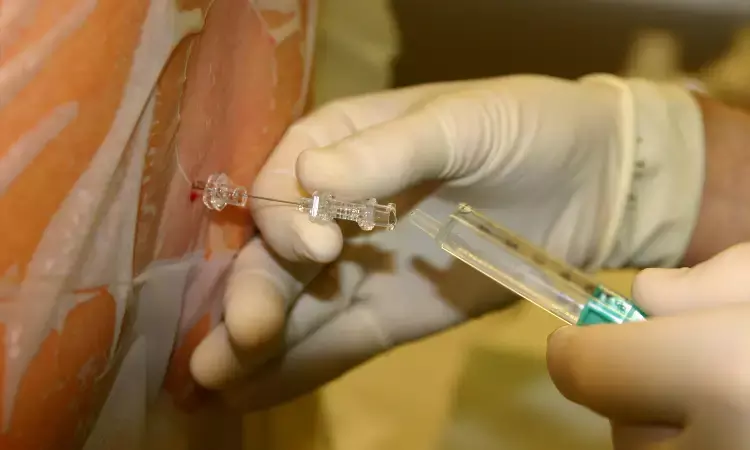- Home
- Medical news & Guidelines
- Anesthesiology
- Cardiology and CTVS
- Critical Care
- Dentistry
- Dermatology
- Diabetes and Endocrinology
- ENT
- Gastroenterology
- Medicine
- Nephrology
- Neurology
- Obstretics-Gynaecology
- Oncology
- Ophthalmology
- Orthopaedics
- Pediatrics-Neonatology
- Psychiatry
- Pulmonology
- Radiology
- Surgery
- Urology
- Laboratory Medicine
- Diet
- Nursing
- Paramedical
- Physiotherapy
- Health news
- Fact Check
- Bone Health Fact Check
- Brain Health Fact Check
- Cancer Related Fact Check
- Child Care Fact Check
- Dental and oral health fact check
- Diabetes and metabolic health fact check
- Diet and Nutrition Fact Check
- Eye and ENT Care Fact Check
- Fitness fact check
- Gut health fact check
- Heart health fact check
- Kidney health fact check
- Medical education fact check
- Men's health fact check
- Respiratory fact check
- Skin and hair care fact check
- Vaccine and Immunization fact check
- Women's health fact check
- AYUSH
- State News
- Andaman and Nicobar Islands
- Andhra Pradesh
- Arunachal Pradesh
- Assam
- Bihar
- Chandigarh
- Chattisgarh
- Dadra and Nagar Haveli
- Daman and Diu
- Delhi
- Goa
- Gujarat
- Haryana
- Himachal Pradesh
- Jammu & Kashmir
- Jharkhand
- Karnataka
- Kerala
- Ladakh
- Lakshadweep
- Madhya Pradesh
- Maharashtra
- Manipur
- Meghalaya
- Mizoram
- Nagaland
- Odisha
- Puducherry
- Punjab
- Rajasthan
- Sikkim
- Tamil Nadu
- Telangana
- Tripura
- Uttar Pradesh
- Uttrakhand
- West Bengal
- Medical Education
- Industry
TAPB most effective Local Anesthetic for pain after Cesarean section: Study

Transverses abdominis plane block (TAPB) is the most comprehensive local anesthetic technique for postoperative Cesarean section analgesia in the absence of intrathecal morphine, suggests findings from a recently published story in Journal of Pain Research .
Cesarean section (CS) is one of the most frequently performed major surgical interventions. Local anesthetic techniques, a universal component of perioperative multimodal analgesia, are reportedly effective in reducing pain scores and opioid requirements.
TAPB was first described by Rafi et al in 2001 and has rapidly gained popularity in the study of local anesthesia for CS. TAPB is useful as a primary mode of analgesia in women undergoing CS who are not receiving neuraxial morphine for any reason. TAPB is also quite useful for opioid-tolerant patients, who often have poorly controlled postoperative pain. However, the optimal local anesthetic technique for postoperative CS pain remains unclear.
For the study design,Six databases were searched, and a Bayesian network meta-analysis was performed. The outcomes included cumulative morphine consumption and pain scores at four time points, time to first analgesic request, postoperative nausea and vomiting, pruritus, and sedation.
Results highlighted the following facts.
- Sixty-eight studies with 5039 pregnant women were included. Six local anesthetic techniques were involved, including transversus abdominis plane block (TAPB), ilioinguinal and iliohypogastric nerve block, quadratus lumborum blocks, transversalis fascia plane block, erector spinae block, and wound infiltration.
- Compared to inactive controls, TAPB reduced cumulative morphine consumption at 6, 12, 24, and 48 h, pain scores at 6, 12, and 24 h (with the exception of 24 h at rest), the risk of postoperative nausea and vomiting, and sedation.
- Compared with inactive controls, ilioinguinal and iliohypogastric nerve block reduced cumulative morphine consumption at 6 and 24 h and pain scores at 6, 12, and 24 h during movement.
- Compared with inactive controls, quadratus lumborum blocks reduced cumulative morphine consumption at 24 and 48 h and pain scores at 6 and 12 h and lengthened the time to first analgesic request.
- Compared with inactive controls, wound infiltration reduced cumulative morphine consumption at 12 and 24 h, pain scores at 12 and 24 h during movement, and risk of sedation.
- Compared with inactive controls, erector spinae block reduced pain scores at 6 and 12 h.
- Transversalis fascia plane block was found to have similar outcomes to inactive controls.
"We found that TAPB decreased cumulative morphine consumption at each time point studied and reduced pain scores within 24 h. In addition, opioid-related side effects, such as PONV and risk of sedation, were also reduced, which may be related to the reduction in opioid consumption after TAPB. Although TAPB did not show an overwhelming advantage over the other five local anesthetic techniques in pairwise comparisons, the benefits of TAPB were clear, and we conclude that this is the most comprehensive local anesthetic technique."concluded the team.
For full article follow the link: https://doi.org/10.2147/JPR.S313972
Source: Journal of Pain Research
Dr Satabdi Saha (BDS, MDS) is a practicing pediatric dentist with a keen interest in new medical researches and updates. She has completed her BDS from North Bengal Dental College ,Darjeeling. Then she went on to secure an ALL INDIA NEET PG rank and completed her MDS from the first dental college in the country – Dr R. Ahmed Dental College and Hospital. She is currently attached to The Marwari Relief Society Hospital as a consultant along with private practice of 2 years. She has published scientific papers in national and international journals. Her strong passion of sharing knowledge with the medical fraternity has motivated her to be a part of Medical Dialogues.
Dr Kamal Kant Kohli-MBBS, DTCD- a chest specialist with more than 30 years of practice and a flair for writing clinical articles, Dr Kamal Kant Kohli joined Medical Dialogues as a Chief Editor of Medical News. Besides writing articles, as an editor, he proofreads and verifies all the medical content published on Medical Dialogues including those coming from journals, studies,medical conferences,guidelines etc. Email: drkohli@medicaldialogues.in. Contact no. 011-43720751


